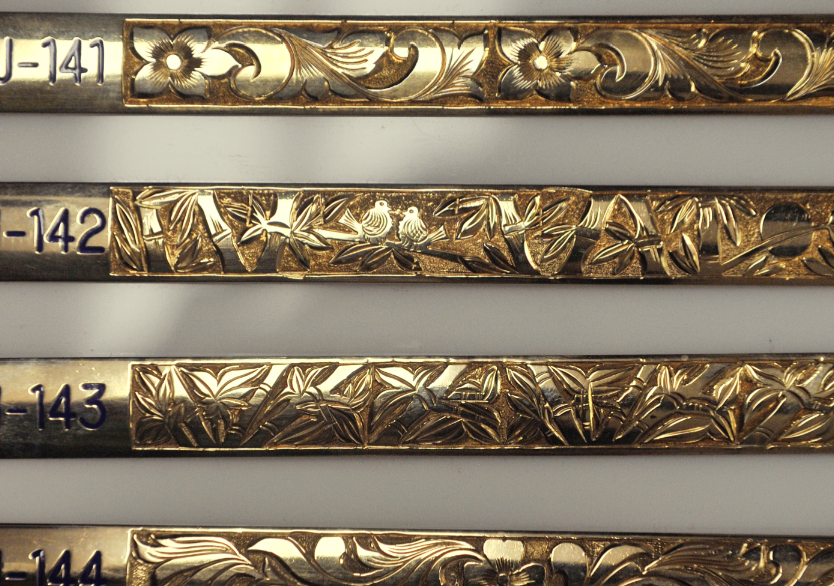Images by John Hook
Daughters, aunties, tutus, sisters, wives, mothers – wrists blinging, waving, clanging — all, suddenly, queens.
I would hear that sound, that clanging, and it would take me back. I was an infant once, and maybe they clanged while she rocked me to sleep. And I was a child once, and maybe they clanged while she washed the dishes, or shook a finger at me, or clapped between tears at graduation.
But I grew up, and I could still hear it. Even on the other side of the world, someone’s bracelets clanged around a corner and I half-expected my mother’s voice to follow. Some sounds are as sacred as blood, as gold.
The trend was born in death. In England, they called it mourning jewelry. Black, Old English lettering on half-inch-wide gold bracelets. Our benevolent Queen Lili‘uokalani visited England and dug this trend. It was classy, unique.
In 1861, Prince Albert, the cousin-husband of England’s Queen Victoria, died, so Miss Vicky wore hers in memoriam. And in 1862, maybe Queen Lili‘uokalani was such a stand-up broad that she had the first Hawaiian bracelet made and engraved with “Hoomanao Mau,” meaning “Lasting Remembrance,” to empathize with a fellow female ruler.
Or maybe our queen had hers made with said engraving as a preemptive message prior to the overthrow to commemorate the native monarchy. Maybe both. And maybe she had a couple more made, and when she lifted her regal arm to wave, they too, released a piercing clang.
Regardless, here in Hawai‘i, the style took off. The monarchy would indeed be remembered forever by the islands’ women. Frankly, solid-gold remembrance looked good with, like, anything. Even mu‘umu‘u – definitely mu‘umu‘u.
So for over the next century, these golden bracelets became one of Hawai‘i’s most precious, in-vogue gifts. It didn’t matter if they were once supposedly mourning jewelry. Miss Vicky was never Hawai‘i’s queen, so we would exalt the living. We’d give them to our sweethearts, emblazoning them with bold Ku‘uipos; to our wives on anniversaries; to chubby newborn babes with even chubbier wrists.
But mostly, we’d give them to our daughters, who’d open up a small box in June, gasp, and then raise their diplomas high. And on their wrists, that gift would hit the one they got for their first communions, or maybe their 16th birthdays, and a thousand clangs would echo across an island. Some sounds are sacred.


But alas, a decline. Over the last five years, the price of gold has than tripled. What was once $400 an ounce currently fluctuates between $1,600 and $1,800 an ounce. Gentle jewelers like the warm-hearted, soft-spoken Ken Tseng of K&J Jewelry Hawaii have witnessed this incident firsthand.
“We’ve made a lot less bracelets for people in the last three to four years,” says Tseng. “And last year, hardly any.”
But surely, despite a global recession, despite gold’s recently erratic behavior, surely people still give gifts. Don’t they? Tseng continues, “Honestly, people want other gifts these days instead of Hawaiian bracelets. They would rather have an iPhone or an iPad or an iPod.” If we’ve forsaken the engraved for the encrypted, why are these bracelets still special? Ken enlightens: “Well, every piece is different. Every piece is handmade; none of our bracelets are mass-produced. They are all individual treasures. Every single piece is one of a kind, and you can wear them.”
Once, that was enough, that 14-karat, smelted singularity. The sound could return, though. Some things gold can stay. If anyone could bring it back, it’d be our women. Our women, who brought them to life, who transformed mourning jewelry into ecstatic, echoing symbols of celebration. Our women, who still wear gifts – from the modest 10mm graduation loop to fabulous 4-inch ghetto gauntlets, stacks on stacks on stacks …
And Ken is right. Each one is different, and you can wear them. And it doesn’t matter if originally you’re a Jewish girl from Fullerton, that your name is Amy but you had it Hawaiianized in Old English to Emi. Some sounds are sacred. And all women can be royal when those bangles are piled up and jangling. Daughters, aunties, tutus, sisters, wives, mothers – wrists blinging, waving, clanging — all, suddenly, queens.

